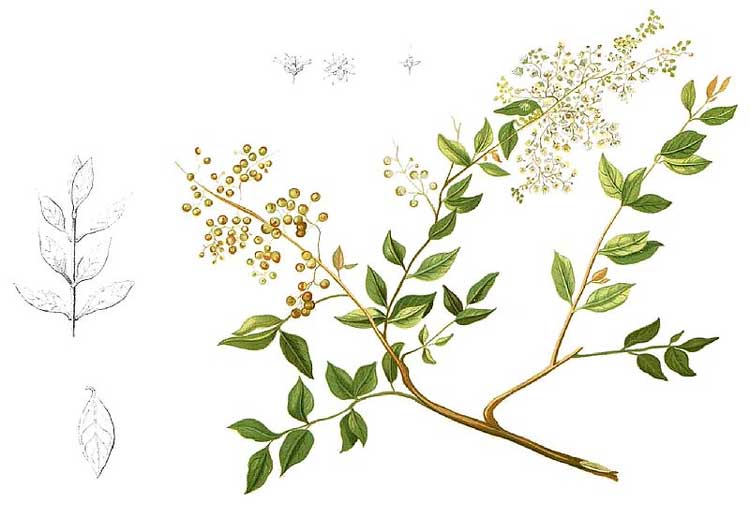
Lawsonia inermis
Classification System: APG IV
Superregnum: Eukaryota
Regnum: Plantae
Cladus: Angiosperms
Cladus: Eudicots
Cladus: Core eudicots
Cladus: Rosids
Cladus: Eurosids II
Ordo: Myrtales
Familia: Lythraceae
Genus: Lawsonia
Species: Lawsonia inermis
Name
Lawsonia inermis L.
References
Linnaeus, C. 1753. Species Plantarum. Tomus I: 349. Reference page.
USDA, ARS, Germplasm Resources Information Network. Lawsonia inermis in the Germplasm Resources Information Network (GRIN), U.S. Department of Agriculture Agricultural Research Service. Accessed: 07-Oct-06.
Vernacular names
български: Къна
bamanankan: Jàbi
cop: ⲕⲟⲩⲡⲣ
dansk: Henna
Deutsch: Hennastrauch
Ελληνικά: Χέννα
English: Henna
Esperanto: Henao
español: Henna
Fulfulde: Puddi, Puuɗudi
suomi: Hennapensas
français: Henné
italiano: Henna
മലയാളം: Mailanchi
Nederlands: Henna
polski: Lawsonia bezbronna
português: Henna
svenska: Henna
Türkçe: Kına
Lawsonia inermis, also known as hina, the henna tree, the mignonette tree, and the Egyptian privet,[3] is a flowering plant and one of the only two species of the genus Lawsonia, with the other being Lawsonia odorata. It is the source of the dye henna used to dye skin, hair and fingernails, as well as fabrics including silk, wool and leather. Medicinal properties for the cure of renal lithiases, jaundice, wound healing; prevent skin inflammation. The bark is traditionally used in treatment of jaundice and enlargement of the spleen, renal calculus, leprosy and obstinate skin diseases. The species is named after the Scottish physician Isaac Lawson, a good friend of Linnaeus.
Description
Henna is a tall shrub or small tree, standing 1.8 to 7.6 m tall (6 to 25 ft). It is glabrous and multi-branched, with spine-tipped branchlets. The leaves grow opposite each other on the stem. They are glabrous, sub-sessile, elliptical, and lanceolate (long and wider in the middle; average dimensions are 1.5–5.0 cm x 0.5–2 cm or 0.6–2 in x 0.2–0.8 in), acuminate (tapering to a long point), and have depressed veins on the dorsal surface. Henna flowers have four sepals and a 2 mm (0.079 in) calyx tube, with 3 mm (0.12 in) spread lobes. Its petals are ovate, with white or red stamens found in pairs on the rim of the calyx tube. The ovary is four-celled, 5 mm (0.20 in) long, and erect. Henna fruits are small, brownish capsules, 4–8 mm (0.16–0.31 in) in diameter, with 32–49 seeds per fruit, and open irregularly into four splits.[4]
Cultivation
The henna plant is native to northern Africa, Asia and northern Australia, in semi-arid zones and tropical areas.[5] It produces the most dye when grown in temperatures between 35 and 45 °C (95 and 113 °F).[6] During the onset of precipitation intervals, the plant grows rapidly, putting out new shoots. Growth subsequently slows. The leaves gradually yellow and fall during prolonged dry or cool intervals. It does not thrive where minimum temperatures are below 11 °C (52 °F). Temperatures below 5 °C (41 °F) will kill the henna plant.
References
"Lawson, Isaac" . Dictionary of National Biography. London: Smith, Elder & Co. 1885–1900. Linnaeus dedicated the genus Lawsonia to Isaac Lawson (d. 1747).
The Plant List: A Working List of All Plant Species, retrieved 23 May 2017
Bailey, L.H.; Bailey, E.Z. (1976). Hortus Third: A concise dictionary of plants cultivated in the United States and Canada. New York: Macmillan. ISBN 978-0025054707.
Kumar S.; Singh Y. V. & Singh, M. (2005). "Agro-History, Uses, Ecology and Distribution of Henna (Lawsonia inermis L. syn. Alba Lam)". Henna: Cultivation, Improvement, and Trade. Jodhpur: Central Arid Zone Research Institute. pp. 11–12. OCLC 124036118.
"henna (plant)". Encyclopædia Britannica. Retrieved 5 May 2013.
Bechtold, Thomas; Mussak, Rita (6 April 2009). Handbook of Natural Colorants. John Wiley & Sons. p. 155. ISBN 9780470744963.
Retrieved from "http://en.wikipedia.org/"
All text is available under the terms of the GNU Free Documentation License

